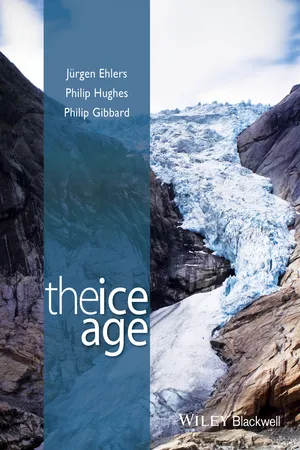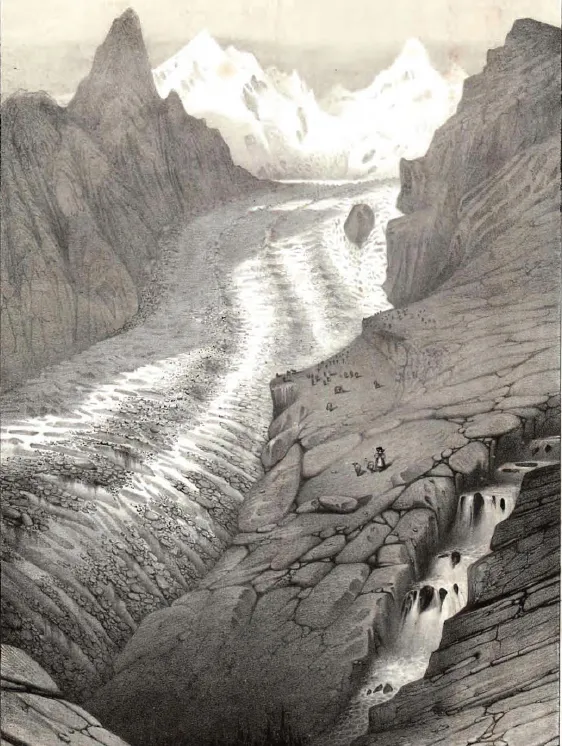
- English
- ePUB (mobile friendly)
- Available on iOS & Android
The Ice Age
About This Book
This book provides a new look at the climatic history of the last 2.6 million years during the ice age, a time of extreme climatic fluctuations that have not yet ended. This period also coincides with important phases of human development from Neanderthals to modern humans, both of whom existed side by side during the last cold stage of the ice age. The ice age has seen dramatic expansions of glaciers and ice sheets, although this has been interspersed with relatively short warmer intervals like the one we live in today. The book focuses on the changing state of these glaciers and the effects of associated climate changes on a wide variety of environments (including mountains, rivers, deserts, oceans and seas) and also plants and animals. For example, at times the Sahara was green and colonized by humans, and Lake Chad covered 350, 000 km2 – larger than the United Kingdom. What happened during the ice age can only be reconstructed from the traces that are left in the ground. The work of the geoscientist is similar to that of a detective who has to reconstruct the sequence of events from circumstantial evidence. The book draws on the specialisms and experience of the authors who are experts on the glacial history of the Earth.
Readership: Undergraduate and postgraduate students studying the Quaternary, researchers, and anyone interested in climate change, environmental change and geology. The book provides a rich collection of illustrations and photographs to help the readers at all levels visualise the dramatic consequences of glacier expansions during the Ice Age.
Frequently asked questions
Information

Chapter 1
Introduction
The Ice Ages! It is difficult, now, to understand the perplexity and bafflement and sheer disbelief that greeted this idea, over a century and a half ago: the idea of vast walls of ice invading from the north to engulf entire landscapes. This seemed like science fiction, a Gothic fantasy on a par with a belief in dragons and fairies and industrious aliens that built canals on Mars.Zalasiewicz (2009, p. 68)
1.1 In the Beginning was the Great Flood
The greatest attention deserve the southward pointed shape of Africa and India, and all the great embayments all around Asia, from the Red Sea up to Kamchatka, all open to the south, which are the surest proof that the Earth once suffered a violent flood from the south, which is also confirmed by the large amount of skeletons of large land animals found in Siberia which are derived from a more southern country.Jerusalem (1774)
The blocks of granite, which have been transported from the heights of Mont Blanc to the Jura mountains, could not have been moved from their parent mountain, which is the highest in Europe, had not that mountain been below the level of the water by which they were so transported.Buckland (1823, p. 221)
In certain countries, we find a number of large blocks of primitive substances scattered over the surface of secondary formations, and separated by deep valleys or even by arms of the sea, from the peaks or ridges from which they must have been derived. We must necessarily conclude, therefore, either that these blocks have been ejected by eruptions, or that the valleys (which must have stopped their course) did not exist at the time of their being transported; or, lastly, that the motions of the waters by which they were transported, exceeded in violence anything we can imagine at the present day.Cuvier (1827, p. 23)
BOX 1.1 DRIFT-ICE TRANSPORT

Table of contents
- Cover
- Title page
- Copyright
- About the Authors
- Preface
- Acknowledgements
- About the Companion Website
- Chapter 1 Introduction
- Chapter 2 The Course of the Ice Age
- Chapter 3 Ice and Water
- Chapter 4 Till and Moraines: The Traces of Glaciers
- Chapter 5 Meltwater: From Moulins to the Urstromtal
- Chapter 6 Maps: Where Are We?
- Chapter 7 Extent of the Glaciers
- Chapter 8 Ice in the Ground: The Periglacial Areas
- Chapter 9 Hippos in the Thames: The Warm Stages
- Chapter 10 The Course of Deglaciation
- Chapter 11 Wind, Sand and Stones: Aeolian Processes
- Chapter 12 What Happened to the Rivers?
- Chapter 13 North and Baltic Seas during the Ice Age
- Chapter 14 Climate Models and Reconstructions
- Chapter 15 Human Interference
- References
- Index
- EULA